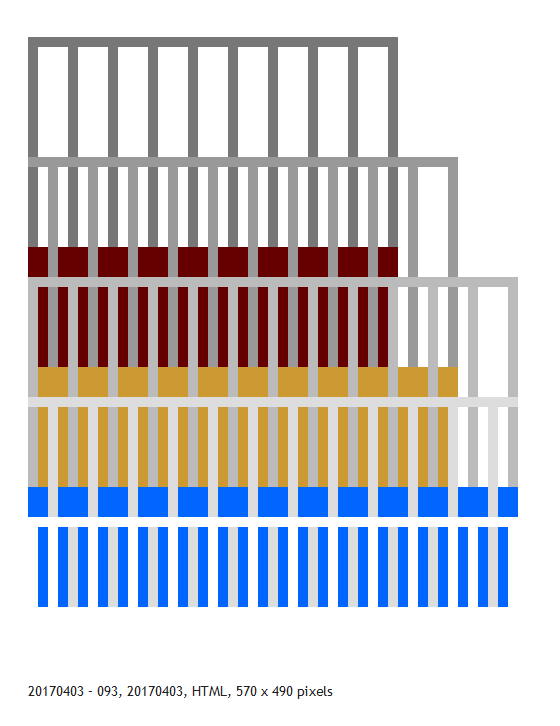
via superamiga (and others): "Ko Hasebe’s photograph of YMO meeting Kraftwerk: Ryuichi Sakamoto, Ralf Hütter and Yukihiro Takahashi, Japan, 1981"
captions added by some cynic

via superamiga (and others): "Ko Hasebe’s photograph of YMO meeting Kraftwerk: Ryuichi Sakamoto, Ralf Hütter and Yukihiro Takahashi, Japan, 1981"
captions added by some cynic

Screenshot of Chris Ashley HTML drawing Returning 08, 20140108 (the HTML original appears on his blog). What could be a Bauhaus design problem ("make a color appear transparent relative to its surrounding color") or a variation on Peter Halley's cell-and-conduit grammar could also be a cartoon floor plan or an especially inept maze. There's quite a bit of wry humor in this simple-seeming pattern.
This and other quasi-pictographic works of abstract art are executed by Ashley in Dreamweaver, a program used for making web pages back in the halcyon DIY days of HTML, before developers commandeered -- some might say "stole" -- online practice away from everyday users through use of complex CSS and javascript routines. Dreamweaver essentially yields a set of coded instructions to "put this color here, put that color there," resulting in ephemeral web browser art, where the browser acts as both canvas and portable art gallery.
Ashley has continued this work as a daily practice since the early 2000s, despite the lack of critical infrastructure that could explain or validate the work. Most of the New Media websites are not comfortable talking about abstract painting, and most critics versed in Ryman and Palermo "don't know from HTML." Worse, technology changes are affecting "browser art" as a neutral, predictable space for viewing work, due to the aforementioned CSS-and-scripting hegemony but also because people increasingly browse on smartphones, which reduce screen widths and alter page layouts.
So-called mobile ready designers don't like HTML tables, due to their unpredictability in different contexts. So what does an artist do when a medium originally premised on wide popular accessibility becomes esoteric due to changing tech? I've been saving these Ashley works as PNG files (with no loss of resolution), which can be easily resized by current browsers. But that's changing the meaning and purpose of the work, to arrive at an "archival" solution. They could also be printed-out as paper pieces but I've seen them in person and they aren't as exciting; they really need that back-lit screen glow to come alive. Lightbox transparencies? Now we're reinventing the work completely. Despite all this fretting, the art is still being made and can still be seen, so check it out!
Dedicated to faux-progressives who think baiting a nuclear-armed power is a keen idea if there's a chance it could dispose of Trump (along with the rest of us). Suddenly we are back in the bad old days of the Cold War and songs like this have become relevant again:
Chrome, "March Of The Chrome Police" (1979)
[hooktube]
I don’t care much about your situation
You’ve got too a strange of a fascination
You’ve got an overactive imagination
A cold clammy* bombing
A cold clammy bombing
Will ruin your town
I hear all the paranoid discussions
Trying to distract me from my functions
But I don’t care what they say
I’m not afraid of the Russians
A cold clammy bombing
Will ruin your town
Some say they saw you lighting up the fuse
Well at last this fucking box will get some use
Modern equipment can’t take the abuse
A cold clammy bombing
Will shit on your town
*spelled "clamey" on the lyric sheet

screenshot from Ashley's blog
I like the imaginary squares at the intersections and the fact that this .png screenshot is only 6 KB. Micro-anything seems radical in this era of social media bandwidth bloat.
Coincidentally when I was reading the Wikipedians' entry on last mile internet delivery I saw this graphic.
Recently had a last mile experience when Comcast stopped providing service to my building because they couldn't access their own utility pole!
Sometime in the dim past, copper TV cable service was installed in the back of my building; Comcast now uses the wires for TV and internet. My cable stretches across three fenced-in backyards to a pole located on property facing an adjacent street. Here's a diagram:

Last week a branch cracked off the Giant Dead Tree (about five stories high) behind Bldg B-2, breaking the cable that extends from the backyard of Bldg B-1 to my building, Bldg A-2. In order to repair the cable, the Comcast technician would have to get the permission of owners or tenants of Bldg B-1 to let him into their backyard so he could climb the pole there. He couldn't get access, so he says, so he gave up and went on to his next job.
Comcast's customer service said the only way I could get the connection restored was to try to convince the residents of Bldg B-1 to give them access to Comcast's pole -- to act as the company's real estate agent, in other words. As if! Comcast was behaving as if it still had a monopoly but FIOS recently came to our neighborhood (via a competitor provider) so I have an alternative to knocking on doors on their behalf.